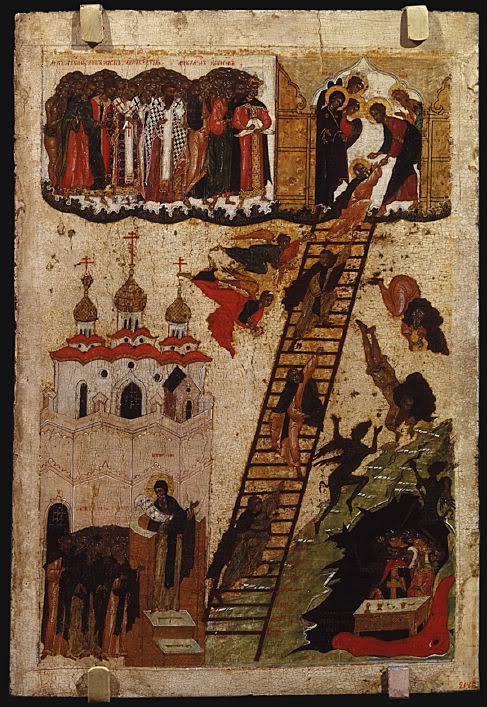Russian Icons
Home
Vision of the Heavenly Ladder

Notes:
The Vision of the Heavenly Ladder
Moscow
"The Vision of St. Evlogii," "The Vision of the Heavenly Ladder," and "The Parable of the Blind Man and the Lame Man," are conceived and executed in similar ways and undoubtedly formed part of a single ensemble. Originally a four- or six-part icon, this assemblage would have been commonly referred to as a 'parable-icon.'
The compositions of icon paintings commonly emphasize diagonals, which in turn, suggest ascent. "The Vision of the Heavenly Ladder," a Novgorod icon of delightful detail and complexity, shows these features helping to unite a field displaying several separate events and settings.
The depiction on this icon follows a familiar text by the sixth-century saint, John Klimakos of Sinai. His epithet, "Klimakos" means "of the ladder." The earliest surviving treatments of the theme of the "Vision of the Heavenly Ladder" in manuscript form date from the eleventh century in European art and from the early fifteenth century in Russia. Icon painters seem to have taken the theme from miniatures.
The ladder is depicted with thirty steps, each representing one of the thirty chapters of St. John of Klimakos' "Book of the Vision of the Heavenly Ladder." Christ helps the monk who has ascended to the final step enter the open gate of paradise. Shown with a golden halo above his head, the monk is greeted by the Mother of God, St. John the Baptist, and the archangels. On the right of the ladder, monks who have failed to reach paradise are shown falling, victims of demons emerging from hell to secure their prey. A red monster, representing death and hell, resides in the abyss beneath the austere fractured rock. Also represented there are Pluto (Hades) and Prosperine (Persephone) garbed in royal vestments, references to the underworld of classical mythology, not uncommon in sixteenth-century Russian art. Every element of the composition, including color, has meaning. Paradise, for example, is represented by the brilliant white area framed by St. Peter's Gates.
To the left of the Gates of Paradise, a group of saints and martyrs on clouds represent inhabitants of the heavenly Jerusalem, praising the Creator. King David is featured playing the lute and singing his psalms. Finally, at the lower left, St. John is portrayed on an ambo (an early Christian raised pulpit) with a scroll. He is reading his composition to the assembled monks who receive it respectfully. Behind the crowd looms a great wall with a three towered church, the architectural foil for paradise represented floating above the scene.

